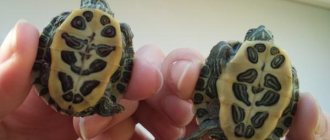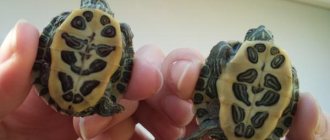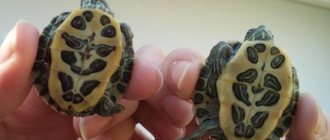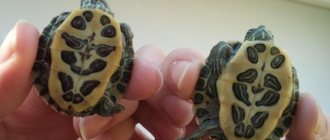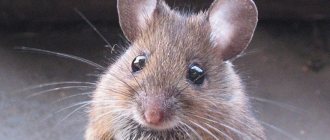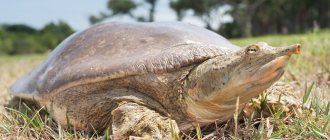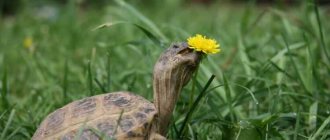For some reason, many people, when buying a turtle to keep at home, think that this animal does not require special care and can live peacefully in an apartment. However, this is not entirely true; perhaps, unlike dogs or cats, they do not have as many needs, but it is still worthwhile to properly equip the place where they are kept, and also think about their diet. First of all, it’s worth figuring out what to feed a river turtle at home, because the health and full development of this reptile depends on proper nutrition.
What do turtles eat in the wild?
The main component of the diet of red-eared turtles in the wild are shellfish: mussels and snails, oysters, and crustaceans. They have no teeth, but this does not prevent them from excellently dealing with mollusk shells: with strong jaws they break them and eat the pulp.
In the summer, insects become food for turtles: grasshoppers, beetles, etc.
They are very fond of algae, plankton and small fish. They also eat tadpoles, fish fry and frogs.
Treats
Supplement the diet of land reptiles:
- champignons, puffballs, oyster mushrooms and other easily digestible mushrooms;
- sunflower seeds;
- bran;
- mango;
- plums;
- peaches;
- beets;
- boiled chicken or quail eggs;
- snails and slugs - once every few weeks.
Feed adult aquatic turtles:
- raw lean meat;
- baby frogs;
- tadpoles;
- chicken, fish, beef liver;
- shrimp;
- octopus tentacles;
- mussels.
Diet of the red-eared slider
A necessary aspect of caring for turtles is preparing the right diet. The health of your pet depends on feeding high-quality, fresh and, importantly, varied food. How the red-eared turtle feeds, how long it lives, and how it feels are closely interconnected.
In captivity, this reptile has little demand for food. For a tough shell and healthy skin, reptiles require both plant and animal products. For turtles up to one year old, the latter must be included in the diet in an amount of 80% or more.
A reptile's hard shell requires plant and animal products.
Mature turtles need to increase the amount of plant foods rich in fiber and vitamins. As a result of eating only meat, pets can develop rickets, hypovitaminosis or obesity.
The required vitamins and dietary supplements must be regularly added to food.
Recommendations for how many times per day to feed your red-eared slider will depend on the age and preferences of the individual reptile.
If the turtle is up to 1-1.5 years old, there should be one or two meals a day. If you have no appetite, reduce the amount of food or go on a short hunger strike for 1-2 days.
To create an optimal nutritional regimen for an adult, you should observe the pet and feed it on demand. If a turtle is hungry, it becomes overly active in the presence of its owner, hitting the water with its paws. After feeding, she calms down and rests calmly. A turtle may require food daily, or maybe once every 7 days.
Should reptiles be given water?
Yes, reptiles need moisture, but some drink no more than once a month, while others drink a couple of times a week, it all depends on the species characteristics of the pet. The composition of the pet’s diet plays an important role in this matter. If a turtle regularly consumes succulent food - fruits, vegetables, succulents, then it needs less water than a pet that often eats dry food.
To improve digestive processes and take care of your pet’s hygiene, it is recommended to bathe your armored friend once every 5-7 days. The reptile is placed in a shallow container with warm water, which should reach the middle of the carapace. Within 20-30 minutes the pet will get drunk and enjoy the procedure
It is important to ensure that water does not enter the turtle's sinuses.
The menu of omnivorous reptiles consists of animal and plant products. Care should be taken that your pet’s diet is not monotonous and includes both ingredients in approximately equal quantities.
Basic feeding rules
To properly feed a red-eared turtle, you must comply with the basic conditions and some subtleties:
- Any food needs to be cut into pieces: the smaller the turtle, the smaller the pieces.
Any food needs to be cut into pieces
- Aquatic reptiles tear large pieces with their sharp claws, so that plant food can be fed whole.
- Before serving, products must be washed, seeds and peels removed.
- The pet should eat the food within 30 minutes. The serving size should be calculated based on this indicator, and should not exceed half the size of the shell. You can also give pieces of food the size of the reptile's head.
- Feed should be given at room temperature. Very cold food is harmful to your pet's health.
- Turtles search for food using their vision. The more attractive the color of the food, the faster she will find and eat it. For this you can use carrots and tomatoes.
- It is better to feed your pet in the morning, but it is not essential. It is important that she has time to digest what she eats during daylight hours or with the lamp on.
- Uneaten food must be immediately removed from the reservoir - this way the reptile will develop the habit of eating at certain hours.
There are different ways to feed armored animals: with tweezers, from a special bowl, or by throwing them into water.
You can feed red-eared turtles with tweezers
It is best to feed the red ear in another aquarium or basin, because leftover food will contaminate the terrarium, and the water will have to be replaced frequently.
You can also teach him to eat on an island equipped in the aquarium. First, food is placed at the very edge of the shore near the water. If the reptile is hungry, it will have to take food. So gradually get used to eating from a small saucer with water.
You should not hand feed your reptile too often to avoid getting used to this method of feeding and refusing to eat differently. There is also a risk of being bitten.
You cannot distract your pet while eating: sudden movements and loud sounds frighten him.
Setting up an aquarium for keeping at home
Caring for and maintaining the swamp turtle subspecies at home does not require the pet's owners to have special encyclopedic knowledge in the zoological field, since they spend most of their time in the aquatic environment. But still, some features of arranging an aquarium for a pet must be observed.
For a marsh turtle, it is necessary to have a spacious aquarium, the volume of which must be at least 150 liters
These are the optimal dimensions of a home for a pet to feel comfortable. It is very important to arrange a small area of land in a reservoir. Despite the fact that swamp turtles are aquatic reptiles, land is vital for them
Otherwise, the animal will simply drown. The optimal size of a land island is considered to be one third of the area of the aquarium.
In addition to water and land resources, the aquarium should always contain other important elements for the reptile’s habitat.
An ordinary electric lamp that will create the optimal temperature in the aquarium
Its placement is recommended above the area of land where the turtle will bask. An ultraviolet lamp, which has a beneficial effect on the health of the reptile, is also important. You also need to take care of the presence of a water filter. Its necessity is due to the fact that the water in the aquarium must always be clean.
As additional elements to create comfort for the animal, aquarium soil is used to imitate the bottom
If you have aquarium plants, it is important that they are not poisonous, since the marsh turtle loves to eat them
What can you feed your red-eared slider?
At home, you can use special food purchased at a pet store to feed your red-eared reptile. If your pet shows signs of illness, for example, a red-eared slider's shell is peeling off, you should pay attention to the quality of its diet.
For the main diet, meat and offal, cottage cheese and eggs are used, as well as fish, seafood and insects. The use of various types of plants, vitamin and mineral supplements is recommended.
Animal feed
This food serves as the basis for the diet of aquatic turtles. For a growing animal, the portion size and variety of food should be increased.
Red-eared turtles prefer live food: snails, small fish, insects and crustaceans. Such nutritional components will be good for diversifying your diet, but you shouldn’t get too carried away with them. It is enough to apply them 2 times a month.
Red-eared turtles prefer live food, but you shouldn’t get carried away with it
Food can be served either raw or cooked, unsalted and unseasoned, divided into pieces.
Meat
The red-eared slider's diet may include lean beef, horse meat, rabbit, chicken and turkey.
Reptiles also eat minced meat. Finely chopped plant food is added there if the turtle refuses it.
By-products
By-products should be added systematically to the red ear's diet. From a wide variety, you should choose only beef or poultry liver and heart. They contain a significant amount of vitamin A, which helps normalize the growth of the pet and maintain healthy skin. Due to a deficiency of this vitamin, detachment of the horny scutes, development of conjunctivitis, etc. are possible.
By-products should be added to the diet systematically
It is recommended to give liver only to adult turtles once every 30 days.
Cottage cheese and eggs
It is difficult to feed cottage cheese to replenish calcium levels to a turtle - it disintegrates in water. But they like to catch it and eat it.
Eggs are used raw, mixed with various types of products.
Fish and seafood
Fish is recommended in raw low-fat varieties (up to 3.0%), such as hake, blue whiting, pollock and cod, and freshwater perch. River species are best suited.
Before feeding, you can remove large bones from the fish, but leave the giblets, because the turtle needs all the useful substances contained in the fish to maintain the rigidity of the shell and skeleton as a whole.
In order to eliminate the negative effects of thiaminase in raw fish, immediately before feeding, it is necessary to put it in hot water for 2 minutes.
Among marine products, green shrimp are used as food for reptiles; they enjoy octopus and squid, and eat mussels and snails.
Reptiles enjoy eating octopus, squid, and shrimp.
If there are fish or frogs living with the turtle, there is a high chance that it will eat them.
Insects
The menu of the red-eared turtle should include insects: beetles and hairless caterpillars. He loves to eat grasshoppers and crickets, earthworms, and also eats mealy bug larvae.
In summer they are collected in the garden and park. But you can’t collect it where it has been treated with chemicals.
Cockroaches caught at home should absolutely not be given in order to avoid insecticide poisoning.
Pet stores sell bloodworms and mealworms to feed armored reptiles.
It is recommended to purchase gammarus - small dried crustaceans. It contains a significant amount of calcium. Koretra and daphnia are also suitable food for your pet.
Insects are used as food for the turtle 1-2 times a week.
Fruits
All types of fruits contain many vitamins.
To the question whether a red-eared turtle can have an apple, there is one answer - you can also have a pear, a banana, an orange and a peach, or a plum and an apricot. Only citrus fruits should be peeled.
You can give your red-eared turtle apple, pear, banana and other fruits.
It is also recommended to occasionally give strawberries, wild strawberries, and pamper your pet with raspberries and other berries. The turtle can also have melon and watermelon.
Vegetables
Vegetables are rich in fiber, which is very beneficial for the gastrointestinal tract, and in particular, the process of food absorption, as well as vitamins A and K, calcium.
These reptiles eat cucumbers, zucchini, cabbage leaves, and red tomatoes, bright sweet peppers, pumpkins, carrots and beets attract their attention. You can even offer beans and asparagus.
They are given raw, without signs of spoilage and without mold. Cooked vegetables have no benefit for the turtle.
Mushrooms
Along with vegetable and fruit food, the red ear can be fed once every 7 days with mushrooms: slices of russula, champignons and boletus.
Greens and plants
These products are also important in the diet of turtles. They must consume them at least 50% of the total diet, and for older turtles this figure reaches 75%.
It is also recommended to feed these reptiles indoor plants, for example, thornless cacti and agave, tradescantia, hyacinth and hibiscus. It is very useful to feed with herbs from meadows, dandelion, coltsfoot, as well as plantain and clover. These reptiles have a good appetite for carrot and beet tops, lettuce leaves, basil and parsley, and dry hay. It is recommended to feed with sprouted wheat or oats (cut sprouts 5-10 cm).
These reptiles have a good appetite for carrot and beet tops
The greens are picked in the garden or in the forest far from roads, sorted and washed.
Aquatic plants, for example, duckweed, hornwort, pistia, water hyacinth, etc. are extremely useful for these reptiles.
It is better to breed them separately. After all, the algae growing in an aquarium with red ear is constantly plucked by it, which disrupts the landscape design. Having eaten algae, she may not accept other food.
Duckweed can be caught from a nearby pond.
Toxic algae (elodea and limnophila) are destructive to turtles.
Food in winter
The change of season is reflected in nutrition. In the summer, feed herbivores and omnivores with greens, vegetables and fruits. Turtles eat frequently and have small portions. In cold weather, reptiles are content with frozen foods and hay; they eat rarely, but in large quantities.
You can plant plants in pots, this will provide the turtles with fresh greens to eat in the winter. Propagate plants such as duckweed or hornwort so that turtles can be fed aquarium flora continuously. To do this, you will need to purchase a separate aquarium and properly care for the plants.
Artificial feed
Pet stores have a wide variety of balanced foods specifically for armored reptiles. They can come in various forms: capsules, tablets, granules and even flakes. And their compositions will vary. But for the most part, the food produced by the manufacturer often does not satisfy all the needs of the reptile’s body.
In essence, turtle food is food for aquarium fish that has been improved to meet the needs of the reptile's body. Due to the specific smell, pets may even ignore it, but over time they get used to it.
This type of feeding is convenient, but you cannot feed it alone
This type of feeding is convenient primarily for busy people, but it is not the only way to feed. Such feeds often do not maintain the balance recommended by veterinarians, which can lead to vitamin deficiency and digestive problems for the animal.
Mineral mixtures and vitamins
It is necessary to feed the aquatic turtle with vitamin and mineral mixtures. Active growth, healthy skin, and proper development of the skeleton and bone tissue depend on them.
Aquatic turtles receive useful substances not only from a variety of foods, but also from special supplements. The diet of such a pet should contain moderate amounts of vitamins A, B12, D3, E, as well as minerals such as selenium and calcium.
Regular feeding with calcium-containing preparations is especially important for turtles to strengthen their shells, especially in growing young individuals. With calcium deficiency, it can become crooked and lumpy. Claws may also become bent, limbs may occasionally break, and in extreme cases, the shell may even fall apart or become like cardboard. In nature, sources of calcium for turtles are limestone, oyster shells, corals, dolomites, and animal bones.
Calcium-rich foods include the popular gammarus. A significant amount of it is found in bone meal, ground egg shells, and also in feed chalk. They are given 100 mg of the mixture per 1 kg of pet’s weight once every 7 days.
The most applicable drugs are purchased at a veterinary pharmacy or pet store.
Feed containing vitamins and minerals (except calcium) cannot be stored for a long time. Vitamins for the prevention of vitamin deficiency C and E and mineral supplements are given only once a month, mixed into the food.
Vitamins and mineral supplements are given only once a month, mixed into the food
To ensure that the turtle consumes all the added nutrients, you should mix them with food and feed them by hand.
Ready-made food in a pet store
Dry food for red-eared turtles can be used only in cases where it is not possible to maintain a balanced diet using natural products.
Although manufacturers promise to fully satisfy the reptile’s needs for the necessary substances, they do not recommend making semi-finished products a monotypic type of food in order to avoid metabolic disorders and problems in the gastrointestinal tract.
Food for cats and dogs
It is not recommended to use either dry or wet dog or cat food for feeding red-eared turtles.
This combination food is specially developed in the optimal ratio for feeding warm-blooded animals, so it is not suitable for reptiles. It contains a set of substances that are absolutely useless for turtles.
Vitamin and mineral supplements for these pets also do not meet the needs of the turtle’s body.
Homemade food for red-eared turtles
It is possible to prepare food for pets with shells yourself at home.
For this you will need:
- cabbage – 50 g;
- squid meat – 100 g;
- lean fish – 145 g;
- carrots – 70 g;
- apples – 50 g.
Grind all the components using a meat grinder, break 2 eggs into it. Dilute 30 g of gelatin in 150 ml of hot water. Mix all ingredients thoroughly with 150 ml. milk.
Grind all components of the feed using a meat grinder
Keep in the refrigerator for 7 days only. Feed in small pieces. This food is enough for 10 meals for one turtle with a shell length of 15 cm.
If you replace gelatin with agar-agar, the food will dissolve more slowly in water.
Here's another recipe for making your own food.
Take the following products:
- squid – 0.3 kg;
- pollock – 1 kg;
- shrimp – 0.5 kg;
- gelatin or agar-agar – 150 g;
- hake – 1 kg;
- water – 750 ml.
Prepare the mixture as follows:
- Grind fish and seafood in a meat grinder.
- Dissolve agar-agar in water and let it swell.
- Mix the resulting minced meat well and heat over low heat for 10 minutes.
- Add dissolved agar-agar, mix thoroughly for 15 minutes.
- Pour the prepared mixture onto a baking sheet or into a plastic container and let it cool completely.
- Place on the refrigerator shelf for 5 hours.
- Cut the resulting mass into small pieces, wrap each in a piece of foil.
- Place them in the freezer.
For feeding, a portion of frozen food is taken out 4 hours in advance and thawed at room temperature.
The food is taken out 4 hours in advance and thawed at room temperature.
This supply will be enough for a red-eared pet with a shell size of 20 cm for a whole year.
Reproduction process
Between April and July, the female makes holes in the ground, into which she then lays eggs. One individual can make up to three clutches, each of which contains up to six eggs. At a temperature of +30 degrees and a humidity of 60-70%, the incubation period lasts from 60 to 65 days.
Between August and October, the eggs hatch into babies that are about 3cm in size.
At home, steppe tortoises can become parents at the age of 5-6 years.
For breeding, a female and two young males are required. After the mating process is completed, the female must be isolated immediately. For 2-3 months, the expectant mother is busy carrying eggs. During this period, her diet should be rich in vitamins and microelements.
The female lays her eggs in the ground and happily forgets about them. They must be immediately taken out and placed in an incubator - a special place where the soil layer is at least 18 cm, the temperature is +29-30 degrees and the air humidity is at least 60%. The individual that has laid eggs should be kept separate from the others for some time, continuing to feed it intensively. This is done to ensure that the animal recovers after pregnancy.
After three months, newborn turtles emerge from the eggs.
Caring for the Cubs
In order to ensure maximum survival of the offspring, certain care is required. Small turtles should not be placed in the same terrarium with adult reptiles, as they can cause injuries incompatible with life to babies. The bottom of the terrarium for young animals is lined with medium-sized sawdust, the temperature regime is the same as for adult animals. The cubs need to be fed plant foods with added calcium.
What not to feed
These aquatic reptiles eat whatever is offered to them. But they cannot digest all the food they eat, which leads to disruptions in the gastrointestinal tract and, consequently, to diseases.
What not to give to a turtle:
- fruits and berries with seeds;
- food from the table;
- sea fish;
- fatty freshwater fish;
- citrus peel;
- flour products;
- onion, radish;
- Turtles have difficulty digesting pork and lamb fatty meat;
- poisonous elodea;
- amber snails.
You should not give a lot or often tomatoes, cabbage, legumes, spinach.
Herbivores
Any vegetables, fruits, root vegetables or greens can be used as the main diet. Starting from dandelions and carrots (clover, thistle, alfalfa, regular lawn grass) and ending with a variety of lettuce, carrots, cabbage, etc.
When preparing a diet, take 2-3 times more greens than fruits and vegetables. As additives to the main food of herbivorous turtles, you can use bran, dry yeast or dried seaweed, and soybean chaff.
What can overfeeding cause?
An important condition for the nutrition of a red-eared pet is not only a variety of diet, but also a regime. Overfeeding leads to diseases: pyramidal shell and obesity.
Not only the diet, but also the regimen is considered an important condition for nutrition.
Overeating in juveniles is extremely harmful, because they are actively developing, as well as during the adaptation period after purchasing or after illness of a red-eared turtle.
It is not recommended to force feed turtles. But long-term fasting is also contraindicated for them.
A healthy reptile should swim freely in the water and easily crawl onto the island. Excess weight will prevent the turtle from hiding its head in its shell.
Caring for your turtle
The first thing you should pay attention to when purchasing a pet is its appearance and size. A turtle that is under 5 cm in size at the time of purchase will be very difficult to raise.
At this age, small individuals are susceptible to various infections and diseases. This is how natural selection takes place. Therefore, a turtle 5–7 cm in size will be the best choice when purchasing.
You should also carefully examine the color of the shell. The claws and tail must be intact. The skin looks healthy and the eyes shine. After the pet is in the aquarium, watch how it swims. A healthy turtle should swim smoothly, without leaning in different directions.
Healthy turtle
Features of treatment
After purchasing a pet and moving it into an aquarium, it may go through an adaptation period. Typically it will take 2 to 5 days. At this time, the animal becomes a little inhibited, or, conversely, very active. There is no need to panic and pick up the animal. Give him peace and time to adapt to new conditions. After a while, the turtle will get used to the new environment and become calmer.
When trying to pick up a turtle, do it very carefully and always with both hands. Not all representatives are willing to make contact. Some may flounder, hiss, and defecate in fear. The shell becomes slippery in water; keep this fact in mind when removing your pet from the aquarium.
After you hold the turtle in your hands, be sure to wash them with soap. Despite being kept clean, turtles are often carriers of salmonellosis. To avoid the spread of infection, you must always monitor the condition of the aquarium and the quality of the food.
Drinking regime
Red-eared turtles from the family of freshwater turtles live in the wild in small lakes with well-warmed water by the sun or ponds with swampy shores. For these reptiles, fresh water is vital (they cannot live without it for even a couple of days). The redfish spends its entire life in water - activity and sleep, eating and the process of defecation.
The red-eared turtle spends its entire life in water - activity, sleep, eating
The question of whether a turtle has a need to drink has not been fully studied. The structural features of her body do not allow water to linger: in the process of drinking, it pours out of her nostrils and flows down her neck. Moisture, so necessary for reptiles, penetrates through its skin, as well as from the products it eats.
Features of feeding small turtles
Particular attention must be paid to feeding turtles, because a deficiency of vitamins can negatively affect their development.
Young turtles are predatory animals, so they often ignore plant foods. Animal food plays a predominant role during their feeding period. They require food 1 or even 2 times every day.
Juveniles desperately need calcium and vitamin D. They should be added to their food at every feeding.
Baby turtles desperately need calcium and vitamin D intake
One of the rules for feeding baby turtles is to serve pieces of food the size of a blueberry.
Description
The European marsh turtle has an oval or rounded carapace, smooth, usually black or yellow-green in color. It is dotted with many small yellow or white spots, sometimes forming rays or lines. The shell is smooth when wet and shines in the sun, and becomes more matte as it dries. The head is large, slightly pointed, without a beak. The skin on the head is dark, often black, with small spots of yellow or white. The paws are dark, also with light spots on them.
Emys orbicularis has several subspecies that differ in color, size or detail, but most often in habitat. For example, the Sicilian marsh turtle (Emys (orbicularis) trinacris) with a striking yellow-green carapace and the same skin color. And Emys orbicularis orbicularis, which lives in Russia and Ukraine, is almost completely black.
Adult marsh turtles reach a carapace size of up to 35 cm and a weight of up to 1.5 kg. Although, when kept at home, they are usually smaller, despite the fact that the subspecies living in Russia is one of the largest.
The European marsh turtle is very similar to the American marsh turtle (Emydoidea blandingii) in appearance and habits. They were even classified for a long time in the genus Emys. However, further study led to the fact that these two species were divided according to differences in the structure of the internal skeleton.
How long does a marsh turtle live? There is no consensus on the life expectancy of a marsh turtle. But everyone agrees that she is a long-liver. The numbers range from 30-50 years to 100.
How long can a turtle not eat?
A red-eared slider may not eat at all for 10 to 90 days; this period is individual for each individual. Young turtles can starve for the least amount of time. In this case, reptiles can lose up to 40% of their mass. But you should not starve them; you should offer food regularly.
When keeping such turtles at home, it is necessary to create feeding conditions for them that are as close to natural as possible. And then the pet will be able to remain active and healthy for a long time.
What do you feed your red-eared pet? Share your experience in the comments.
Heating
Natural sunlight is best, and it is advisable to expose baby turtles to direct sunlight during the summer months. However, this is not always possible and an analogue of sunlight must be created artificially.
To do this, in an aquaterrarium, above land, an incandescent lamp and a special lamp with UV rays, an ultraviolet lamp for reptiles (10% UVB), are placed.
Moreover, the height must be at least 20 cm so that the animal does not get burned. The temperature on land, under the lamp should be 30-32°C, and the length of daylight should be at least 12 hours.
In nature, they spend the winter and hibernate, but in captivity they do not do this and there is no need to force them! Her home conditions allow her to be active throughout the year; it’s not winter when there’s nothing to eat.
